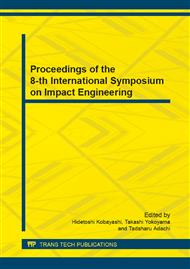p.158
p.167
p.173
p.179
p.185
p.193
p.199
p.205
p.211
Improving Rebound Models in 3D Rockfall Simulation Codes Used for the Design of Protection Embankments
Abstract:
Rockfall propagation simulation models are widely used for assessing rockfall hazards as well as for the design of rockfall protection structures. This research work investigates the relevance of rockfall propagation models to assess rockfall hazard in the vicinity of embankments. In this article, particular focus is placed on the development of engineering oriented rebound models taking into account the shape of the block. Two different block impact modelling approaches are considered and compared. Small scale experiments involving blocks with different shapes impacting a small-scale embankment were conducted to provide data for calibrating the models. The trajectory of the blocks was tracked using a high speed camera (1000 fps) and an image processing algorithm was developed to extract the experimental trajectories. The two different approaches considered for modelling the impact of the block in the embankment vicinity were a probabilistic block impact model and a deterministic approach accounting for the block shape. In this latter case, the impact was calculated using an elasto-plastic contact model between the block and the slope surface. Both approaches succeed in simulating experimental results. Nevertheless the probabilistic model is limited by the introduction of the block shape parameter in the calculation while the deterministic approach seems to be limited in terms of computational efficiency.
Info:
Periodical:
Pages:
185-190
Citation:
Online since:
June 2014
Authors:
Keywords:
Price:
Сopyright:
© 2014 Trans Tech Publications Ltd. All Rights Reserved
Share:
Citation:


